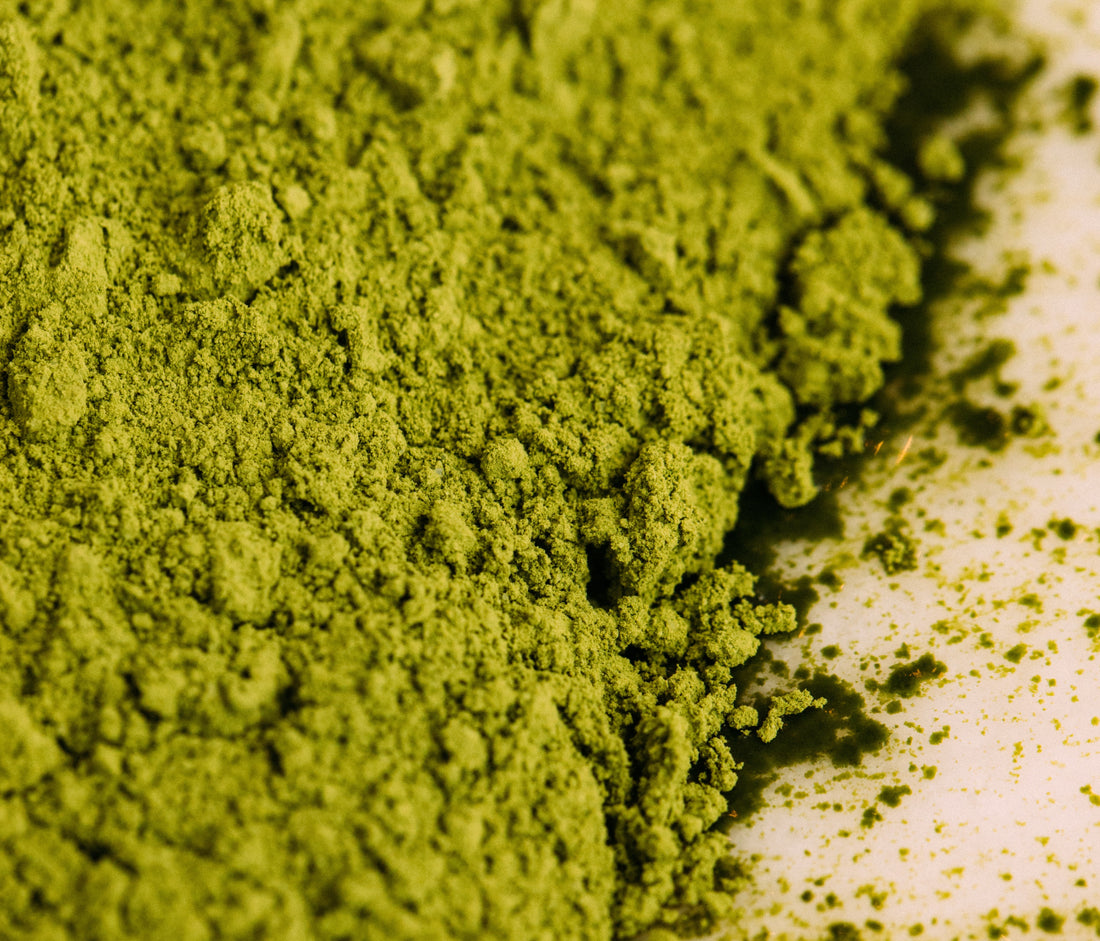I know what you're thinking—another matcha article? Yes, but hear me out—there are a lot of great articles about the history of matcha, how it came to be and its amazing cultural significance. But we want to talk about something different. Matcha has been a mainstay in so many cultures because the benefits of matcha are noticeable and immediate. It's got a unique set of compounds that are grown and brewed in unique ways, so let’s do a deep dive into the science behind this magical tea.
What Are the Brewing Methods Used in Matcha Lattes and Other Matcha Drinks?
We’ll start where most of us start—brewing. For the typical process of brewing tea that isn’t matcha, you use loose leaf or tea bags filled with dried leaves, other herbs, botanicals, spices and fruits, submerge them in hot water and extract their flavorful compounds. Once finished, you take the tea bag out and discard it. But not for matcha! If you’ve ever made matcha, you know it’s a simple powder that you mix into hot water, no fancy bags or contraptions are required. This is because matcha is a suspension tea, meaning the compounds in matcha don’t fully dissolve like sugar or salt would, but float suspended in the water, eventually being pulled to the bottom of your mug by gravity if you don’t drink it fast enough.
What gives matcha this unique suspension property is that the powder is made up of the entire tea leaf ground very finely. Compare that to the tea leaves in your tea bag where you give them a hot dunk and toss them; with matcha, you’re getting the whole leaf. This means big water-insoluble compounds like fibers, proteins, carbohydrates and other nutrients present in the leaf make it into your mug and give matcha its unique flavors and benefits.
Matcha Powders Have Different Grades (And We're Not Talking About School Grades)
But not all matcha is equal—if you’ve scratched the surface of this green powder, you’ll quickly come to the various grades you can find. Culinary, premium, ceremonial, café, ingredient. It’s easy to start associating these with letter grades or how good or bad the matcha is, but it’s not that simple. For starters, there are no consistent grading criteria across matcha growers. Terms like culinary and ceremonial are customer-facing terms—in reality, growers separate matcha into different categories depending on their own internal grading systems, typically based on when and how the leaves are grown, various measured chemical compositions as well as blending practices across the growing season.
A higher grade, such as ceremonial or premium will have a deeper green color and be less bitter with the classic umami taste. A lower grade such as culinary will have a more yellow-green color with a stronger bitter flavor. Is one better than the other? Well, it really depends on what you want to use it for. If you're drinking it straight in water, the best experience will be using a higher grade because you’ll experience all the nuances and characteristics matcha has to offer without any one flavor being overpowering or off-putting. If you’re going to be making a matcha latte, loading it with cream and sugar, baking with it, or making candy, you’ll generally want a lower grade. Lower grades tend to have a stronger flavor that may be overpowering when just in water, but work well when pairing with other ingredients so the matcha flavor doesn’t get lost. A grower once gave the following anecdote that I think gets the point across really well.
"Using ceremonial-grade matcha in a flavored latte or in a baked good is like making pasta sauce with a $500 bottle of wine," said the grower. "Yes, you can do it, but you’ll likely get the same great-tasting pasta sauce using a $15 bottle and will save yourself $485."
Why does matcha have grades, anyway? Why isn’t it all just high quality? It comes down to the growing process. At the start of the harvest season, growers will cover the plants from direct sunlight, called “shade-grown”. When denied direct sunlight, the leaves compensate by making more chlorophyll, which of course makes it greener, but also boosts amino acid production. This leads to a more balanced and complex flavor and is typically only done for the first round of harvests. Subsequent harvests use full sun growth to help the plants produce more leaves. In full sun, the plants produce less chlorophyll and amino acids, leading to a more yellow-green color and a lower grade while at the same time, increasing antioxidant production due to sun exposure.
What Are the Benefits of Matcha?
Along with caffeine, many of the benefits of matcha come from its antioxidant and amino acid composition. As we learned above, it’s reported that higher grade matcha, shade grown, will have increased amino acid production while full-sun grown, lower grade matcha, may have higher antioxidant levels. We’ll dig into what benefits these provide, but the differences demonstrate why grading isn’t so simple—it comes down to what benefits you are looking for and how you are going to use the matcha that determines which type is best for you.
Speaking of benefits, let’s break down why caffeine, amino acids and antioxidants give matcha the moniker “liquid meditation”.
Matcha tea is one of the best sources of EGCG, a polyphenol antioxidant catechin (pronounced cat-uh-kin). If you’re my age, you probably recognize EGCG from Snapple bottle labels; it’s a unique and well-researched plant compound with an amazing antioxidant capacity that synergizes with the vitamins and minerals found in matcha.
As mentioned, shade-grown matcha promotes the production of amino acids, the most well-regarded is theanine. Theanine comes in two isomers—l-theanine and d-theanine. Isomers are essentially compounds of the same chemical makeup, but different shapes. Imagine you have two eggs and you hard-boil one and make the other one sunny-side up. They are both still eggs, just made in two different ways. This is essentially what an isomer is. Much of biochemistry has to do with shapes, and how things fit together, so the efficacy of each of these isomers of theanine are different based on their shape. L-theanine is the most researched for efficacy over the d-variant, and it’s proven to promote relaxation and calm feelings as well as support focus and immunity. Studies show when paired together, l-theanine and caffeine in levels found in matcha boost laser-focus and clarity.
What Exactly Does Matcha Taste Like?
A fun experiment to do at home (yes, there’s homework with this article, sucka!) is to brew matcha at different temperatures. In doing so, you can actually taste the catechins, theanine and caffeine in matcha. If you have a variable-temp kettle or a thermometer, try brewing matcha at the following temps:
|
65°C / 150°F |
At this temp, theanine is extracted from the ground up tea leaves, but very little of the catechins and caffeine are. You’ll find theanine has a very mellow and sweet taste. |
|
75°C / 165°F |
Rising the temp up to 75°C, you’ll extract both theanine and catechins. On top of the mellow sweetness of theanine, you’ll now get a complex astringency. The flavor will start getting interesting and you’ll find yourself starting to move your head to music that isn’t really playing. |
|
100°C / 212°F |
At a full boil, you’re extracting everything above plus caffeine. The taste of caffeine is very bitter, which will taste sharp and pungent. Often times people are exposed to matcha brewed improperly, and it’s easy to see why some may not enjoy this experience! |
It’s typically recommended that straight ceremonial matcha be brewed at 70°C so you aren’t overwhelmed with too much astringency and bitterness while still enjoying the mellow sweetness of the theanine and overall umami-flavored complexity. But, if you’re able to, play around with temperatures and discover the flavor you find most enjoyable.
Matt Held is MUD\WTR's Senior R&D Manager specializing in food science.
Photo by charlesdeluvio on Unsplash
Read More: What’s Mycelium? The Unbelievable Story of Fungi’s Underground Mycelial Network
Read More: Have You Heard of the Ancient Turmeric Drink Jamu?
Listen: Cordyceps, Zombies, and the Apocalypse with Matt Held - Manager of R&D with MUD\WTR




